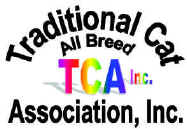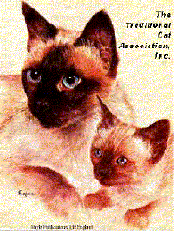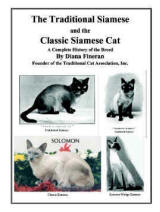|
EXEMPLORY SIRES AND DAMS
We are in receipt of a wonderful and fascinating story from
Rebecca Kopp, about her Cats and Blue Eyed Six Cattery. Your going to love it.
Here goes.
By Rebecca Kopp and Larry Alexander, Intelligencer Journal
Staff Reporter.
“I thought this would be fun information for you! My
Cattery Name came from my past Great Grandfather Drews and Great Uncle Frank
Strichler.
Blue Eyed Six
Della Mae Drews

They wrote a book about it and a play about “The Blue-Eyed
Six”. It played at Mount Gretna in Hershey and Lebanon and the large Fulton
Opera House in Lancaster and now a documentary about the Blue Eyed Six men will
be filmed. My first male stud Siamese was named Blue Eyed Six Little Man Drews
after Charles Drews and some of my Queens are named after past family members.
This started because my father, John, hates cats and could
not understand why you would have them in the house. Much less breed a cat on
purpose! Over the years I have meet some outstanding people and have a lot of
funny stories about the kittens and new owners. The cats and kittens have
brought great joy to us and the many people who adopted them as family members.
It also brought great perks. I sold three to someone in VA., who has given me a
key to their Million Dollar beach house in Topsail, NC. We have used it two
times so far. I received free tickets to NY theaters from producers in NY and
some other fun things thru friendship I made over the years. I want to express
my thanks for all the help you have given me over the years and all your hard
work on behalf of TCA, INC.
Life insurance was already a multi-million dollar industry
in PA. In 1878. It was after the war and many in the Indiantown Gap area came
from making a living to the north, Schuykill County and the mountains that are
full of coal. Those miners were wild and reckless fellows who lived outside of
the law. Some of the Mollie McGuires were hanged for stealing and murders. But
there also were a lot of German people trying to farm and make a living.
The Blue Eyed Seven were all neighbors around the small
outpost town known as Indiantown Gap in the Mountains near Lebanon, PA. Israel
Brandt owned the tavern he built at St. Joseph Spring. Charles Drews was
Brandit’s nextdoor neighbor. Drews is my Father’s, Mother’s Great Grandfather.
He came from Germany and had bad luck in American, working as a mason and iron
worker. He married and had eight children ranging from twenty-three down to one
year in age in 1878. He did enlist in the Civil War in PA. Volunteers and
served four years and was an excellent soldier. After the war he went back to
Lebanon County again and slipped into being a day laborer and occasional
farmer.
The other four principals in the Joe Raber “Group Insurance
plan” lived down the valley six or seven miles east of Brandt’s tavern. Henry
Wise, George Zeckman and Josiah Hummel and Charley True were close neighbors and
knew each other well. All of German ancestry. During the summer and fall of
1878 these three men, Wise, Zechman and Hummel were frequent visitors at
Brandit’s tavern were the plan was hatched out.
During that fall of ‘78’ a new resident appeared at
Brandt’s tavern. Nineteen year old Franklin Stichler had been born and reared
about half a mile away from St. Joseph Spring from a large German family. He
was my Father’s Great Uncle. Frank was a young man and very handsome with large
blue eyes, square chin, thick black hair and mustache. A lot like my Father
when he was a young man. It turned out that Frank meet Charley Drews daughter,
Lena, who was a pretty, young nineteen year old, blond with blue eyes and
married to Joseph Peters, who was in the Army.
It was soon noticed that there was a strong attraction
between Frank Stichler and Lena. Soon Lena’s husband returned from the Army to
interrupt Frank and Lena. Old Joseph Raber was heavily insured by the six with
different insurance Companies. Each holding insurance policies on him.
George Zechman was acquitted but the other six were hanged
for the death of Joseph Raber in the stream in the back of Brandt’s tavern. The
turning point in the trial was the testimony of Joseph and Lena Peters, who said
they heard the six talking about the murder and how they drown Raber and how
they put their wet cloths to dry. Most of the family members of all the family
knew about the plan to kill Raber, but out of jealousy and revenge for Frank
Stichler having an affair with his wife, Lena, Joseph Peters told the police
everything.
In the succeeding years, the story was to be told again and
again in County by many newspapers. It was Lebanon’s most sensational news
story ever to come out of Pennsylvania history. Drews and Stichler were
executed by hanging together.”
Rebecca’s Father gave pictures and the information that
came down through the family for the following article that was published in the
Intelligencer by Larry Alexander
“Brothers plan movie about blue-eyed bandits, Scene to be
shot for documentary in Mount Joy.”
Wanted: Five blue-eyed men with an interest in getting
hanged for murder.
That’s what brother Brian and Bruce Kreider hope to find as
they begin casting for a documentary film they plan to make called “The
Blue-Eyed Six”. The film tells the story of a gang of thieves hanged for an
1880 murder involving insurance fraud.
“We’re looking for men with the bluest eyes we can find,”
said director/writer, Brian Kreider, former director of the Pennsylvania Film
Office. The one thing about this story that’s haunting is the fact that all six
men had sinister blue eyes.” The filmmakers have already cast one of the gang
members, but need five more. Actors can range in age from 18 t0 60. The
Kreiders also are looking for about 100 extras for crowd scenes at the
hangings. Auditions and interviews will be held starting at 11 a.m. July 10 at
Bube’s Brewery, 12 N. Market St, Mount Joy.
Also wanted are people with knowledge of the case willing
to be interviewed for the documentary.
The six gang members – Frank Strichler, Charles Drews,
henry F. Wise, Josiah Hummel, Israel Brandt and George Zechman – were backwoods
men from the mountains around Indiantown Gap. They routinely raided farms,
stole livestock and robbed travelers on the roads between the county seats of
Lebanon and Harrisburg.
Not content with those activities, they purchased a life
insurance policy on a hermit named Old Joe Raber.
“In those days, anyone could take out insurance on any
other person so long as the insured agreed,” Brian said, “So they found old
Raber and took out a joint policy.”
The men paid the premiums. Then they got greedy and
decided to help the old man along on his journey. On Dec. 7, 1878, Raber was
found drowned in the icy waters of the Indiantown Creek near Moonshine Church.
The six might have gotten away with it, but a member of the
gang began courting 19 year old, Magdelena Peters. This didn’t sit well with
her husband, Joe, who told the justive of the peace in Hummelstown that he had
witnessed the murder, even though it was near dark and he was, by his own
admission, nearly 700 yards from the crime scene.
The trail became a media circus, drawing reporters from
Pittsburgh and Philadelphia. (Word even reached Sir Arthur Conan Doyle in
London, who used the premise to write the Sherlock Holms mystery “The red-Headed
League.”)
The insurance company paid for a first rate legal team and
even brought in a judge and district attorney from Harrisburg for the trail in
Lebanon.
“The law and the insurance industry wanted to make an
example of these men and send a powerful message on insurance fraud,” Brian
said. “These poor guys had no money for a legal defense and the thought seemed
to me, “Let’s just nail these guys and make an example of them,” So, in a sense,
the criminals are victims.”
Even newspapers at the time saw this not just as the
conviction of five men for murder (Zechman was acquitted), but as an indictment
of the insurance industry. On May 19, 1880, just after the hangings, the
Lancaster Weekly Intelligencer wrote that not all the guilty had b een punished:
“There yet remain unpunished the insurance agents who induced this gang of men
to insure Raber’s life for speculation. The agents have received their
commissions, the insurance companies have pocketed the premiums, they escaped
paying the loss and they escaped the gallows.”
The Kreiders, whose most recent work, “Milton Hershey, The
Play,” was performed on the Fulton Opera House stage last summer, first
introduced audiences to “Blue-Eyed Six” in play form in 1994.
“We played to packed houses in Hershey, Lebanon, Mount
Gretna and Lancaster,” Brian said.
Brain next wrote a screenplay, but couldn’t sell the idea
to movie studios in Los Angeles.
“We go close on a few occasions, but it lacked redeeming
qualities,” Brian said. “In other words, there’s no true hero in the end.”
From that, plus a trip to the Sundance Film Festival in
200, where Brian heard actor Robert Redford talk about the need to bring
documentaries to the forefront, came the idea for this film version of “The
Blue-Eyed Six.”
“Redford’s whole thing was documentaries are great
stories,” Brian said. “Let’s stop making dry subjects and put some oomph into
them. Let’s add some drama and get them plastered on the big screen.”
“Principal filming will take place starting next month and
last into late summer,”said director of photography David Garman of Kirkwood.
Exterior locations include Tulpehocken Manor in Berks County. Interiors will be
shot mainly at Bube’s Brewery, using the upstairs bar as the bar room of the
Lebanon Hotel, where the plot was hatched, and the dark caverns of the catacombs
as the prison where the men were held before their executions. Brian said the
finished product will be a 55 minute documentary suitable for TV and a ‘cut down
version” for the film festival circuit.”
When I absolutely jumped at the chance of publishing this
story in our Newsletter, Rebecca completed this saga with, “Thanks, Diana, for
your interest. Over the years I tried to stay in the background, but friendly
with any one I meet or purchased cats from. We are going on our second and
third generations of Siamese and I always tried to have very healthy loving
kittens to make people happy. In the end a good breeder wants only what TCA’s
motto is, “Promote and Protect” our breeds of cats. Thanks. Rebecca.”
This story really got my imagination going because I saw
they were casting for actors with blue eyes. I immediately called John and
asked him to audition. I don’t know about the “sinister” eyes deal, because
John has happy striking blue eyes. Being hanged for murder though, would be a
bit rough to say the least! Then I read on and saw that the casting was done on
July 10th. My idea of being the wife of a famous movie star faded
into the dust that created that thought. Drat! Missed that one!
Rebecca responded to my mischief, “Shame John didn’t get a
good part in the movie. He could have stayed with us when filming. He may have
had to share a bathroom with Sarah who is due any time! She likes to have them
in the upstairs hall bathroom linen closet. She likes to stroll out of the
bathroom and take Mommy breaks and thinks they are hidden from everyone else!”
|

 The
Traditional Cat Association,
Inc.©1987®TM
Official Website
The
Traditional Cat Association,
Inc.©1987®TM
Official Website
